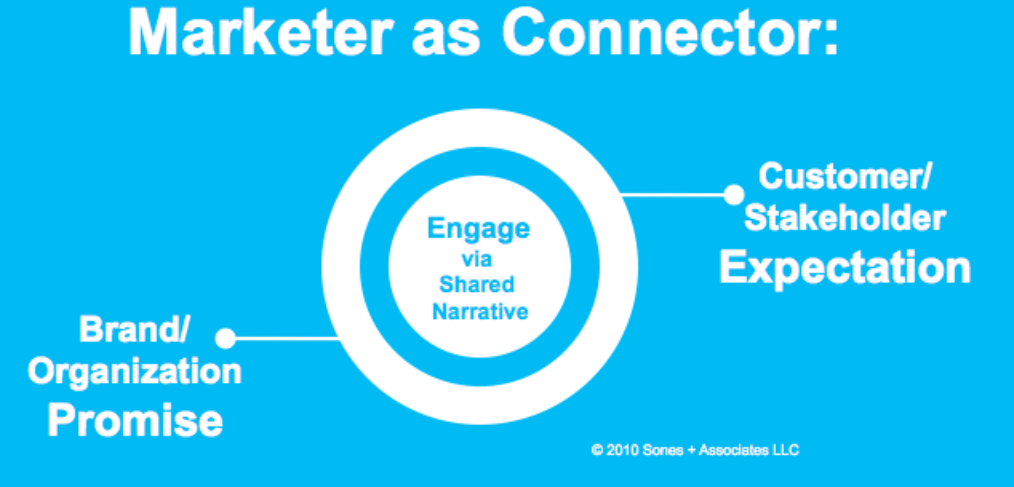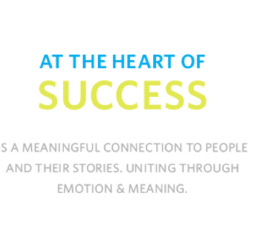
Busting Up A Tired Mindset
Everyone’s grappling with change, seeking to identify and validate a new set of rules for business success. All roads seem to be leading toward a need for businesses to be more “human” and “social.” Seems simple enough. Yet, I think we’re still talking around it all, just scratching the surface for what it really means. My intuition tells me these are Big Thoughts with huge implications for how we market and do business. As I struggle to get my arms around them, I’ve started to realize that the limitations of my thinking — and perhaps the mindset from a traditional marketing background — are holding me back.
I don’t pretend to have the answers. But I’m going jump head first into an attempt to start to make some sense of it all. How can we connect the dots between what seem to be somewhat vague concepts to form a new vision of social enterprise that creates value for all? That’s no short order. Something tells me it won’t be pain free — perhaps challenging all my pre-conceived notions about the role of marketing and brand. So, I’m going to start by busting up a few notions that, while may seem obvious, are important to identify and dispel.
Social Is About Relationship, Not Media
Social this and that is ubiquitous. If Jan Brady could chime in, she’d probably just sigh, “social, social, social.” The conversation, however, is an important one: informing how we’ll organize and engage to do business, get things done and create value. So, we find ourselves talking about important and related topics focused on technology, media, currency, value and economy. This makes perfectly good sense. And yet, I’m left feeling, well, empty. Like I just ate a huge meal, only to pop up a half hour later still hungry, looking for something more substantive. So why am I having such a hard time understanding how all these concepts all fit together? Maybe a good starting point is realizing that these topics are a little off for understanding the heart of social beings: the role of trust and relationships.
The discussion has been diverted, in part, because it all began with social media. We buried the lead and the great disservice is that it’s set us all up to think incorrectly. Here’s why: when we hear “social media” our brains, or a least this one, initially heard the word media. The broadcast-out variety of television, radio, and print. This really confuses the issue. I mean, seriously, can you imagine coining the phrase, “telephone media?” The phone is simply the host, the means, for a conversation. What most of us have done is place a limited framework and business model (an old-school broadcast advertising based one at that) upon our association with the word social. Who are we kidding? As marketers, we were thrilled to find another channel for outbound marketing, since so many other doors have been slammed shut. Unfortunately, we’re now spending our time backpedaling to remind people that, in fact, that’s not what social is even about. If you want to engage, we’re told, it’s all about two-way dialogue. Isn’t that a ridiculous and elementary thought for anything called social in the first place? And yet here we are, still talking about it. To leap forward will require breaking free from advertising-based thinking as we know it to start focusing on building real relationships with people.
We’ve Been Hiding Behind Marketing?
During the recent BrandsConf, digital strategist Dave Wieneke commented that we can’t hide behind marketing like Oz behind the curtain pulling all the strings. I’ll admit it: the statement made me recoil in slight self-defensiveness. My cringing comes from the core implication of the word “hiding” — that marketing is somehow less than noble and honest. That’s not a very appealing thought to attach to one’s profession and it’s never been at the core of my own desire to portray anything as less than authentic and real. But, to recognize my own bias, I realized I’m probably still holding on to some long-held notions of what core activities are involved — and still adequate — for connecting products and services with customers. A more social and human business may require different approaches and mindsets for understanding consumer behavior, motivations and drive than I’ve traditionally considered. Maybe I’d have to identify and challenge all my existing notions to expand my thinking?
To be honest, I must dig deep to understand the frameworks to which I’m clinging, because I love brands. Love them. In all their glory: the promises, the aesthetics, the stories and (gasp!) even the ads. But here’s the rub: the key to building lasting relationship isn’t found in organizational, big-brand messaging to the little people. It requires we step out of the corporate ivory tower and into a real relationship with people. The faceless mass of “consumer” should have a real name and a life in which we are engaged. Not superficially, but for real. You know what’s amazing about Zappos? Tony Hsieh is accessible. Send him a tweet and you’ll hear back. He’s not hiding behind a massive façade of corporate PR and customer service mantras. He’s not superficially making claims behind a tagline. He’s living proof that you can come out from behind the curtain and it can be a real advantage.
So, if we peel away the layers of marketing and brand what do you get? People. Promises. Expectations. All interconnected by relationship forged through trust and a common bond of shared narrative. If we’re honest (why stop now?) this can be scary. Because it’s going to expose us – anyone in a business – and require us to be “out there” like never. Open to criticism. Mistakes. And all our humanness. But the rewards can be bigger than ever.
What’s holding you back?



